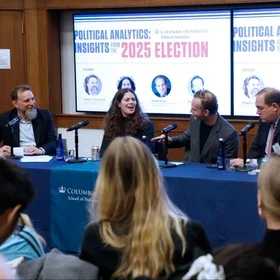by Aaron Abrahms, '03BUS and Jordan Sprechman, '83CC, '86LAW
Lecturers, Wealth Management Program
Ultra-High Net Worth (UHNW) U.S. families have an important estate planning decision to make by the end of this calendar year. The question is how much, if any, of their $11.58 million lifetime gift tax exclusion gift to use.
First, let us take a step back to explain the lifetime exclusion. Under current law, a U.S. citizen or resident generally would owe, at death, U.S. estate taxes (at 40%) on assets in excess of $11.58 million, or $23.16 million for a couple, passing to (or in trust for the benefit of) non-spouse, non-charity recipients. The law also allows a taxpayer to give away to those recipients during their lifetime, without paying for gift taxes (also at 40%). Giving wealth away during lifetime is generally prudent if the donor is sure they can afford to do so because growth on the amount given away would not be subject to future estate tax.
The maximum amount that can be given away, either during lifetime or death, free of U.S. estate tax has been increasing through much of our careers. In 1997, that amount was $600,000. It became $1 million in 2002, $5 million in 2011, and $11.18 million in 2018–but is scheduled to revert to $5 million (inflation-adjusted) on January 1, 2026.
Fewer and fewer Americans have had to deal with the U.S. estate tax in recent years, but that trend may soon reverse. Speculation is rife that, given that the U.S. debt-to-GDP ratio is likely to eclipse the level reached in World War II, the federal government will be tasked with increasing tax revenue gift and estate exclusions are one of the areas of focus for legislators. Even under current tax law, as noted above, the exclusion amounts are scheduled to be cut by more than 50% by 2026, and there is talk of new legislation that would accelerate the timing of the reduction while potentially scaling the exclusions back even below the $5 million thresholds set in 2011.
Additionally, there is a discussion on Capitol Hill of a proposal that would repeal the rule that the basis of assets owned by a decedent would generally be “stepped up” from their cost to their fair market value as of the date of death.
Advisors will recall the rush of estate planning activity in the fall of 2012: The law setting the lifetime gift and estate tax exclusion amounts were scheduled to decrease from $5.12 million to $1 million without any action by Congress. (In the event, legislation preserving the exclusion amounts at $5 million, inflation-adjusted, was enacted around New Year’s Day 2013.) This fall could see a similar level of activity in the advisory community (although a critical difference is that in 2012, the exclusion amounts were set to decrease automatically, whereas a decrease in 2021 would require new legislation by Congress).
In any case, just as they and other families debated this issue in 2012, UHNW families today across the board are considering how and whether to make gifts to other family members up to the lifetime exclusion amounts.
The decision of whether to make lifetime gifts is a complex and nuanced one. For starters, because lifetime gifts are irrevocable, the donor must be sure that they can safely part with the assets gifted and not affect their lifestyle. Second, whether a gift is made outright to one or more recipients, or to a trust of which one or more of them are beneficiaries, is a critical decision. Minor children and other family members generally receive these gifts not outright, but rather in trust. The terms of those trusts–including how long the trust is to last, under what circumstances income or principal are to be distributed, who the trustees are to be, and who pays the taxes on trust income–should be carefully thought through before any gifts to them are made.
Independent of what, if anything, happens with the exclusion amounts next year, when interest rates are low, as they are now, still other planning opportunities for UHNW families exist. For example, a parent–especially one who has already used all of his or her lifetime exclusion amount–may lend money to a child (or a trust for the child’s benefit) based on the published applicable federal rate (AFR). Because this is a loan, not a gift, the parent does not use any lifetime exclusion in transferring assets to the child. The child borrower would owe interest at prevailing rates. For instance, in September 2020, the minimum interest rate that can be charged for a nine-year loan is 0.35%. To the extent the borrower can invest the money in such a way as to generate, say, a 5% average annual return over the life of the loan, that “excess” of 4.65% (5% minus 0.35%) amounts to a tax-free gift to the child (or the trust, as the case may be).
As we think about all of this, it will be a busy fall in the advisory community. The political uncertainty, combined with a possible reduction in the historically high lifetime exclusion amount, combined with historically low-interest rates, has created a perfect storm of opportunity for UHNW taxpayers.
Learn more about Columbia's new Wealth Management program.


